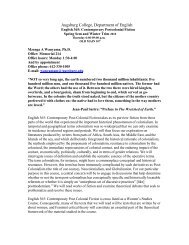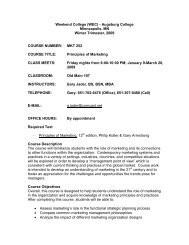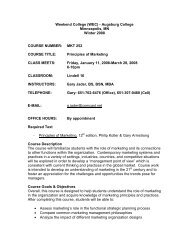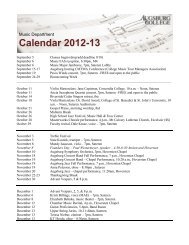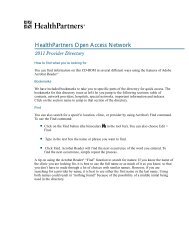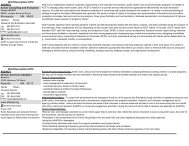You also want an ePaper? Increase the reach of your titles
YUMPU automatically turns print PDFs into web optimized ePapers that Google loves.
Geometry: A Shapely Approach to Math<br />
The following activity is aimed at helping the students discover these answers through trial and error.<br />
First, have the group cut out the pre-made triangles and Information Slips. To begin the activity, have students<br />
pair off. Then have one student in each pair pick a triangle while the other takes an Information Slip.<br />
The student with the Information Slip should then ask his or her partner for pieces of information.<br />
* These can be any combination of angles and sides, but be specific. For example: “Give me<br />
angle b, angle c, side A, and side C,” rather than “Give me two angles and two sidese.” You may<br />
want to emphasize the importance of keeping track of the angle and side names. (We named them<br />
for a reason!)<br />
The student with the triangle should then take the appropriate measurements and tell his or her partner,<br />
who can then write them down on the Information Slip. Now the task is for the student with the Information<br />
Slip to try to create (draw) a congruent triangle with the specified information. Remember: sometimes this<br />
will be possible and sometimes it will not. It all depends on how much and which pieces of information a<br />
student has about a triangle. It may be worthwhile to have both students in each pair take a triangle and an<br />
Information Slip. This way, both can be trying to construct each other’s triangle at the same time, and the<br />
group will have twice as many trials.<br />
The following discussion questions may be appropriate to ask during the activity, or they may be more<br />
appropriate for after the activity. Use your judgment. The goal of asking these questions is to guide discovery<br />
and help students summarize their findings. Here are the questions:<br />
• Is it necessary to have all six pieces of information (i.e.: all three angle and all three side measure-<br />
ments) in order to construct a congruent triangle?<br />
* Why do you think this is?<br />
• Was anybody able to do it with five pieces of information? Four? Three? Two?<br />
* Why do you think this is?<br />
• Of the people who tried using three pieces of information, were you always able to successfully<br />
construct a congruent triangle? (Hopefully someone answers no!)<br />
* What happens if the three pieces of information are all angle measures? If nobody has<br />
tried this, have the group try it and see what happens. (It is impossible to construct a congru-<br />
ent triangle knowing only the angle measures. These triangles will have the same shape but<br />
not necessarily be the same size. These are called similar triangles. There are pic-<br />
tures of examples of these at the end of the lesson.)<br />
* What happens if the three pieces of information are all side lengths? Again, if nobody has<br />
tried this, do so. (This, perhaps surprisingly, will produce a congruent triangle! Given three<br />
lengths, there is only one way for them to fit together and make a triangle. Cool!)<br />
• What combinations of three pieces of information do not work?<br />
* For a specific combination that doesn’t work, have one student who tried this combination<br />
explain in his or her own words why this is.<br />
• What combinations of pieces of information do work? (Below are some definitions that help us talk<br />
about these combinations. Refer to the pictures at the end of the lesson for examples of each.)<br />
* S-A-S stands for “side-angle-side” and means that if you tell me the lengths of two sides<br />
and the measure of the angle between them, I can construct a triangle congruent to yours.<br />
* A-S-A stands for “angle-side-angle” and means that the measures of two angles and the<br />
length of the side in between them is also sufficient information.<br />
* S-S-S, or “side-side-side” also works. That is, if you tell me the lengths of all three sides<br />
(but don’t tell me any of the angle measures!), I can construct a congruent triangle.<br />
• Why was it important to name the sides and the angles?<br />
27



